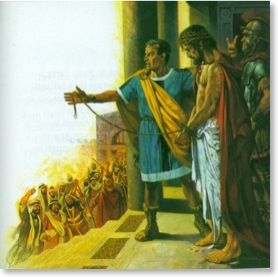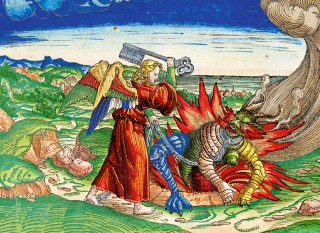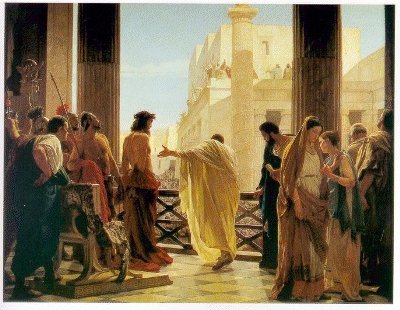
Reprinted from Meridian Magazine (19 Jan 2009).
©2009 by John P. Pratt. All rights Reserved.
| 1. The Scapegoat |
| 1.1 The Ceremony |
| 1.2 Christian Interpretation |
| 1.3 The Enigma |
| 2. Barabbas |
| 3. The Book of Enoch |
| 3.1 Azazel is Satan |
| 3.2 Satan Responsible for Sin |
| 3.3 Cast into the Bottomless Pit |
| 4. Conclusion |
| Notes |
The elaborate "scapegoat" ceremony from the Law of Moses is one of the most puzzling rites of all. Alfred Edersheim, a noted scholar in the field, admitted, "Everything about it seems strange and mysterious."[1] This article looks at the ceremony in some detail to appreciate the enigma, considers two opposite interpretations, and then offers a proposed solution.
This brings us already to the first confusing meaning of this word and of the ceremony itself. On the one hand, the goat takes upon him the sins of the people, and on the other hand, he is set free in the wilderness. The first meaning of the word given above refers to one who is blamed (and usually punished) for the sins of others, but the ceremonial goat seems to be more of an "escape goat" who ends up going free. That is the first clue that there may be a puzzle here that needs to be solved. So let us look more carefully at the ancient Biblical ceremony.
Two nearly identical he-goats were chosen from the congregation of the children of Israel and presented to the high priest. He would "cast lots" to determine which was "for Jehovah" and which "for Azazel" (Lev. 16:2,7,8, where Azazel is often translated "scapegoat"). Tradition is that he did this by reaching with both hands into a large golden urn which contained two lots, which were identical in size, shape and material. He picked one in each hand, one reading "for Jehovah" and the other "for Azazel". Each goat stood by one side of the priest, and the fate of each was determined by the lot chosen by the hand on that side.[3]
 |
There is an interesting twist to be learned from the Jewish records of how this was actually performed. The goat was taken to a certain place in the wilderness to the projecting edge of a steep cliff below which were many jagged rocks. It was steep enough to insure the death of the goat from the fall. So technically, it was "released" in the wilderness, but over the edge of a cliff! That reverses the entire fate of the goat from what is usually assumed. In actual practice it was not released to freedom but to die a miserable death. Most commentators are quick to point out that the custom must have been added after the law had been given,[4] but even so, it clearly indicates that the understanding of those doing the ceremony at that time was not that the goat was released to freedom.
An explanation from a bible dictionary may be helpful here:
". . . the man in whose charge the goat was sent out, while setting him free, was instructed to push the unhappy beast down the slope of the mountainside, which was so steep as to insure the death of the goat, whose bones were broken by the fall. The reason for this barbarous custom was that on one occasion the scapegoat returned to Jerusalem after being set free, which was considered such an evil omen that its recurrence was prevented for the future by the death of the goat."[5]
If this quote correctly explains the origin of the custom of sending the goat to its death, it at least shows us their interpretation of the symbolism of releasing the goat. The Hebrew word "azel" which Tyndale translated "escape" is better translated as "go away completely" or "go away forever" as in "their power is gone" (Deut. 32:36).[6] My suggestion for the best translation of Azazel is "banished goat". The scapegoat is not intended to "escape" but instead to be cast out into an uninhabited wilderness to be "gone" forever from the people. That much is in the actual law of Moses, as understood by those who performed the ceremony.
The Christian interpretation of the scapegoat has seemed obvious. The scapegoat bore all the sins of Israel and so did Christ. The scriptures make it clear that Christ suffered for our sins and paid for them in full. That is the whole point of the Atonement, and that is a core belief of true Christians. The scriptures proclaim, "Surely he hath borne our griefs and carried our sorrows" (Isa 53:4). Indeed, William H. Hunt, who painted in 1854 the magnificent scapegoat shown in Fig. 1, had it framed with an inscription including that very verse. In every Christian interpretation known to me, the scapegoat is said to represent Christ.[7]
And even if He is a goat in this case, the other goat of this pair seems like a much better candidate. After all, he was the one chosen to be "for Jehovah", and he was sacrificed to atone for the sins of mankind, as was Christ. If the scapegoat represents Christ who bore all of our sins, then what was the point of the other goat which was sacrificed to pay for them? Most commentators conclude that both goats represent Christ, but have no compelling explanation for the difference between them.
Why were two goats necessary? Both of them were said to atone for or bear mankind's sins. Have there been two people in history who have done that? If so, did the one who is not Christ have any experience similar to that of the scapegoat? The standard answer is that only Christ suffered for our sins, so they must both symbolize Him. But when was it that Christ was led into the uninhabited wilderness to be banished forever? Why is it worth mentioning that the scapegoat was led by an "appointed" (translated "fit" in the KJV) man? Does he represent someone in particular? And if it was Christ he was leading, why was that man "unclean" afterward?
Is the additional feature of sending the goat to its death off a cliff into jagged stones a barbaric perversion which reverses the whole concept of freeing the goat, or does it capture the intended symbolism of sending both goats to their death by different means? If the scapegoat was intended to be freed, then why does it get off with no suffering, if it is bearing the sins of all mankind? That certainly doesn't seem to be like Christ, who suffered more than is humanly possible. And if the cliff death is a correct symbolism, or even being exiled, then what does it correspond to in the life of Christ?
What is the point of the elaborate ceremony where lots are chosen to determine the fate of each? If two animals are needed for some reason, why not just sacrifice one and let the other one go as was done with birds in the cleansing of a leper (Lev. 14:1-7)? Why have spectators witness the high priest determine which goat was which? Who cares which goat is chosen? Surely the answer has something to do with the fact that one was "for Jehovah" and the other "for Azazel", so another question is, what does Azazel really mean?
Let us dig deeper to answer all of these questions.
 |
Does anything in that episode sound reminiscent of the scapegoat ritual? Let's see. Both men had been condemned of crimes, hence the goat is an apt symbol for each. They both appeared before a man whose decision held their life in the balance, to die or to be set free. And then one man was sacrificed and one was indeed released. So if this event was prefigured by the ceremony, it could explain a) why Christ was symbolized as a goat, b) the meaning of choosing lots as judging between them,[8] and c) that the scapegoat did not also represent Christ, hence the need for two goats. But then who does the scapegoat really represent? Would it be just some random prisoner?
The full names of both men may throw some light on the subject, for both men were misnamed. Jesus was called Jesus bar Joseph (Jesus, son of Joseph), but he was really the "Son of the Highest" (Luke 1:32), the son of God the Father, not the son of Joseph. The full name of the other man was Jesus bar Abbas, meaning Jesus, son of the high father.[9] So the one with what should have been Christ's full name (Barabbas) was not the Christ at all.
Was this similarity of names due to random chance, or is it a clue we can use to solve the puzzle? Let us hypothesize that the idea being symbolized is that the judgment is being made between the true Christ and a false Christ. In other words, Barabbas was not just a random prisoner, but someone who in one sense appeared to be the Christ. That would explain the use of two nearly identical looking goats.
If this incident was indeed symbolized by the scapegoat ceremony, several questions remain. If the scapegoat represents a false Christ, then what about bearing the weight of the sins of all mankind? And what about being led by an appointed man into the wilderness? We may be on the right track but we need some more answers.
If so, then the scapegoat does not represent just any false Christ, but the greatest false Christ of all. In fact, it brings to mind the scene before this earth was created, where two great spirits stood before God, one being Jesus Christ (Jehovah) and the other Satan (Azazel):
And the Lord said: Whom shall I send? And one answered like unto the Son of Man: Here am I, send me. And another answered and said: Here am I, send me. And the Lord said: I will send the first. (Abraham 3:27)At that time, Satan used the identical wording of Jesus. It is as if he were trying to appear to be an equally good choice to be the Christ. Moreover, God himself is making the judgment between the two candidates. And afterward Satan is cast out of heaven, down to the earth where presumably no man had yet dwelt.
That episode truly seems to match the scapegoat ceremony well. Two nearly identical sounding candidates to be the Christ appear before God, who is represented by the high priest, and who judges between them to pick the true Christ. That emphasizes why the decision made by lots was important enough to be done publically by the high priest. And then one goat goes on to become the atoning sacrifice and the other is cast out (released into the wilderness). If that scene was indeed intended to be represented by the scapegoat ceremony, then the symbolism is truly rich.
If Azazel is Satan, then what about the fact that all sins of mankind are put on the scapegoat? It is that single point that has caused Christian scholars to reject this hypothesis and to identify both goats as Christ. Edersheim, in his 18-page description of this one ceremony, rejects this possibility in one sentence, stating that it has "insurmountable difficulties" and implying that they are so obvious as not to require even mentioning.[14]
So is Satan responsible for all sin? Does he in fact carry the weight of the sins of all mankind?
 |
Thus, it could well be that at the Judgment Day many will indeed use the defense that they really have been hornswoggled and never would have sinned if only they had not been deceived. But part of our test here on earth is to see if we can discern the difference between Christ and Satan. That is the very "scapegoat dilemma" each of us must face: "Which is the True Voice to heed?" Christ's sheep know His voice (John 10:3-4). Those who choose Satan may not qualify for either the celestial or terrestrial kingdoms. But the final judgment between the telestial kingdom and sons of perdition is deferred until the end of the Millennium, after Satan has been bound for a thousand years. It has been suggested that the whole purpose of binding Satan might be to determine who was really deceived (telestial) and who actually prefers to follow Satan (sons of perdition).[15]
With all that in mind, consider what the Book of Enoch has to say on the subject. Raphael, one of the seven chief angels of God, is told by the Lord, "And the whole earth has been corrupted through the works that were taught by Azazel: to him ascribe all sin" (Enoch 10:12).[16] There it is in one sentence. Satan is said to bear the responsibility and guilt for all sin on earth.
If so, then it makes perfect sense to lay all our guilt on the goat representing Azazel. In that sense, Satan is entirely guilty and responsible for all sin, but Christ is perfectly innocent and yet suffers and pays for all our sins. So two goats are indeed necessary to show the complete picture.
Now we come to the question of whether Azazel gets off the hook and is released to run free in the wilderness because of Christ's atonement, or whether he too must suffer for his sins. Indeed, will he someday also be punished for all the sins of mankind?
And again the Lord said to Raphael: Bind Azazel hand and foot, and cast him into the darkness: and make an opening in the desert, which is in Dudael, and cast him therein.
And place upon him rough and jagged rocks, and cover him with darkness, and let him abide there forever, and cover his face that he may not see light.
And on the day of the great judgement he shall be cast into the fire. . . .
And the whole earth has been corrupted through the works that were taught by Azazel: to him ascribe all sin." (Enoch 10:4-6, 12)
 |
Note the close comparison to the description of the final end of Satan in the Book of Revelation.
And I saw an angel come down from heaven, having the key of the bottomless pit and a great chain in his hand.
And he laid hold on the dragon, that old serpent, which is the Devil, and Satan, and bound him a thousand years,
And cast him into the bottomless pit, and shut him up, and set a seal upon him, that he should deceive the nations no more, till the thousand years should be fulfilled: and after that he must be loosed a little season. . . .
And the devil that deceived them was cast into the lake of fire and brimstone, where the beast and the false prophet are, and shall be tormented day and night for ever and ever. (Revelation 20:1-3, 10)
Here John clearly saw an angel cast Satan into a bottomless pit, apparently with the express reason to prevent him from deceiving the nations. Combining this with the above quote from Enoch implies that Raphael was the angel who binds Satan, and that the bottomless pit corresponds to the cavern opening up in the earth filled with jagged stones.[17] Then both books agree that the final end of Satan is that he is cast into the lake of fire (see also 2 Nephi 9:16,19; 28:23; Jacob 3:11; D&C 76:36).
 |
One practical lesson to be learned is that it can be very difficult to judge between the two nearly identical goats, representing Christ and a false Christ. Jesus appeared to the Jews to be a false Christ. They believed He performed His miracles by Satan's power (Luke 11:15) and some may have thought they were doing Jehovah a service by crucifying Him (compare John 16:2). Even though they were fulfilling scriptural prophecy, the Jews chose poorly between Barabbas and Christ.
Perhaps next time the choice will be between two lambs instead of two goats (Rev. 13:11). Satan is the great deceiver and can do miracles (Rev. 13:13-15). He disguises himself in sheep's clothing (Mat. 7:15). The Savior warned us not to be deceived by false Christs who will show great signs and wonders, who will, were it possible, deceive the very elect (Mat. 24:24).
If we had to choose between two candidates, both of whom claimed to be Christ, to do miracles and to have the power to save us, would we vote for the One who is indeed the true Savior? Would we go along with the screaming crowd and cast our vote against Christ, or would we have the courage to stand against the throng and heed the still, small voice that testifies of the true Son of God?